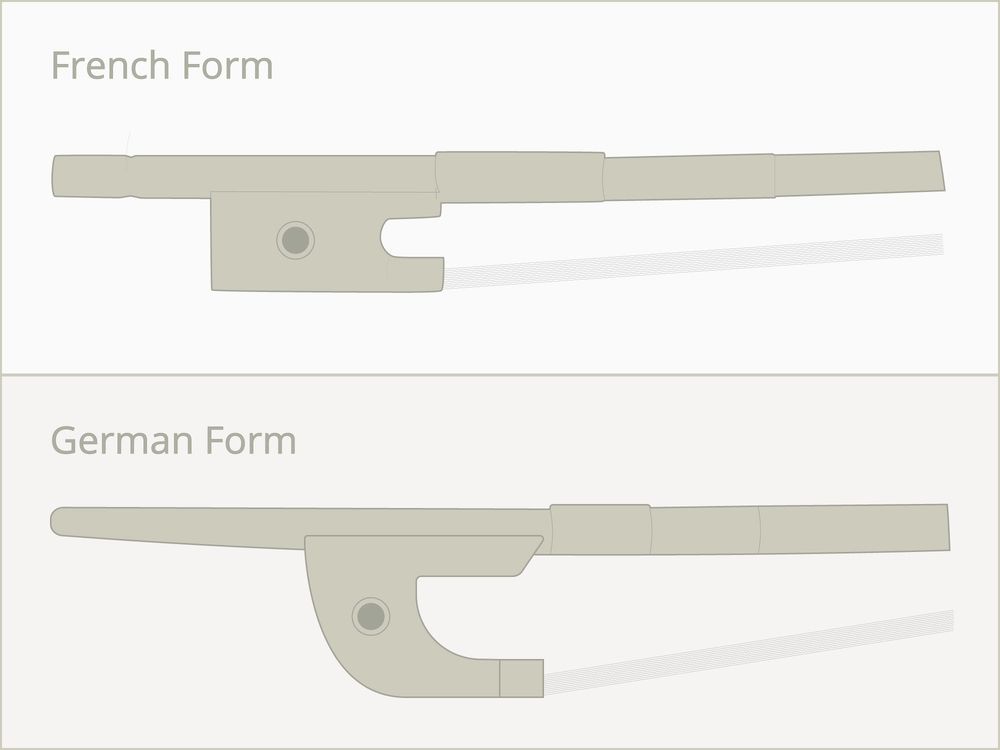9. The Bow
In what is becoming a recurring theme in this tale of "all things bass", the bow is another area where there is no absolute standard as such. There are basically two types of bow in use, the "overhand", or French bow (along the lines of violin, viola and cello bows) and the "underhand", or German bow (based on the bows used on earlier instruments such as the viol). The choice is purely a matter of taste, although in the UK the French bow is by far the most common - check which style your prospective teacher is comfortable with.
Stick
As you might expect, bass bows are a fair bit more heavily constructed than those of other string instruments, with a greater width of horse hair to play on. At the same time, perhaps surprisingly, they are also shorter. The stick can be round or sometimes octagonal in section, but neither signifies higher quality, it is simply a matter of taste on the part of the maker. Pernambuco wood (from the state of Pernambuco in Brazil) is used for the majority of bows by virtue of its immense strength and spring-like flexibility. Brazil wood (something of a poor relation to pernambuco) is often used to make student bows, but the most interesting alternative material is carbon fibre, the use of which is rapidly expanding and is one of the only instances of a modern technology successfully flourishing in the ancient world of string instrument manufacture. While the world's finest bows are still of wood, carbon fibre makes a good case for itself, both in terms of cost and performance in the low to mid price range. It has the added advantage of being practically indestructible and inert to changes in temperature and humidity.

German style (above), French style (below)
Frog
The block that is mounted at the held end of the bow is known as the frog and is usually made of ebony (occasionally tortoise-shell or ivory) and inlaid with mother of pearl. The shape of the frog is the most obvious differentiation between the French and German types of bow as can be seen in the photographs. The metal fittings (the screw, the ferrule and occasionally the bow tip) can be of nickel, silver or gold, usually depending on the quality of the bow, and it is by turning the screw at the end of the frog that the hair is either tightened or slackened. When playing, the hair needs to be tight, but it is very important to remember that the sticks natural curve (down towards the hair) should never be lost through over-tightening, let alone forced to bend left or right. When not in use, the bow should always be stored in the case with the hair un-tightened in order to avoid distorting the stick.

Pernambuco bow with ebony frog & silver lapping
Lapping
"Lapping" is the name given to the binding that covers the stick just before the frog. To a certain extent, it protects the wood from wear, but principally, it is there to ensure a degree of grip for the performer's first finger. A variety of materials can be used, most commonly silver wire, but also whalebone (alternate spirals of black and off-white), though these days, it is more likely to be imitated in plastic!
Hair
Famously sourced from the tails of horses, it is the hair that literally draws the sound out of the instrument. Put it under a microscope and you'll see that each strand is covered in tiny barbs - it is these that cause the strings of the instrument to vibrate when the bow is drawn across them. While white hair is considered the most desirable on the rest of the string family, due to the smoother, finer sound it draws, this is less of an issue for bass bows, so it is not unusual to see them haired in black hair, or sometimes a mixture of both, known as "salt and pepper".




